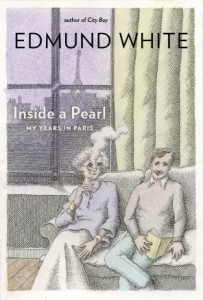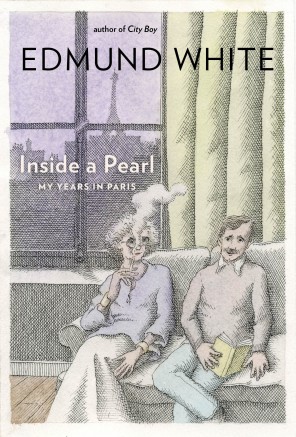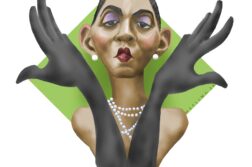 Inside a Pearl: My Years in Paris
Inside a Pearl: My Years in Paris
by Edmund White
Bloomsbury. 263 pages, $26.
WHEN I MOVED to Paris a few years ago, I brought with me Edmund White’s slim 2001 book, The Flâneur, A Stroll Through the Paradoxes of Paris. I took it to bed with me at night those first two weeks in the city. Like White, I moved to Paris in my early forties, and I wanted a book about Paris that captured the city from a later point in life. Our image of the city of light can so often be a youthful one, trapped in 19th-century flamboyance and opulence or in the glittery world of expat artists and writers in the 1920s. Part of the romance with Paris rests on this youthfulness. A line from Balzac that appears early in The Flâneur best sums up the city, even at this point in history: “In Paris there are only two ages, youth and decay; a bloodless, pallid youth and a decay painted to seem youthful.”
Throughout The Flâneur, White beautifully navigates these paradoxes as he strolls around the city, taking us from immigrant neighborhoods in the shadows of Sacré Coeur, to gay and straight sex clubs, to curious small museums dedicated to hunting, perfume, locksmithery, and even romance. Reflecting on an essay by Walter Benjamin, White writes: “the flâneur is in search of experience not knowledge … for the flâneur the experience remains somehow pure, useless, raw.” In this way, White is the perfect flâneur, finding his way into the chic salons and the cruisy backstreets and public parks, always eager for experiences intellectual, erotic, or both. And, as his new memoir Inside a Pearl: My Years in Paris makes clear, he recounts that experience with candor and insight.
White arrived in Paris in the summer of 1983, armed, he writes, “with the success of a novel, A Boy’s Own Story, and a Guggenheim fellowship.” He also arrived with John Purcell, his lover at the time who was a design student and nearly twenty years his junior. Planning on staying for just a year, White ended up living in Paris for nearly a decade and returning in the summers until the late 1990s. It was during those years that he researched and wrote the exhaustive biography of Jean Genet (1993), and a short one on Proust (1999). He published three novels: Caracole (1985), The Beautiful Room Is Empty (1988), and The Farewell Symphony (1997), a collection of short stories Skinned Alive (1995), and a second collection of stories about AIDS with the British writer Adam Mars-Jones entitled The Darker Proof: Stories from a Crisis (1987). He was also a prodigious freelance writer, publishing articles and interviews for a number of American and French publications. All this while learning how to speak French.
Given these accomplishments, I find it striking how little White talks about his writing in this memoir. If you’re curious about his methods of working, what routines he performs each morning (or night) before sitting down at his desk, or what creative habits he embraces, you won’t find much of that here. Among his social circles, White relates how reluctant he was to describe his writing process. “I wanted to pretend it all came effortlessly to me,” he writes, adding, “that was my myth of myself.” Instead, Inside a Pearl, like his 2009 memoir City Boy about his life in New York in the 1960s and ’70s, is filled and fluffed with the author’s personal encounters from the famous to the anonymous and everyone in between.
“I discovered France through Marie-Claude de Brunhoff,” begins the memoir. MC, as White refers to her, stands as the central character in his Parisian life, introducing him to a chic and connected crowd of French and European artists, designers, and writers. Married to Laurent de Brunhoff, the writer and illustrator for the Babar the Elephant children’s books that his father created in the 1930s, MC opened a door that few American expats get to enter in Paris: connections with Parisians. This is the curious reality of Paris. The walls between expat Americans and natives are often quite high, each side protecting itself against the other.
Such connections produce their own self-conscious cultural exchanges, as anyone who has ever spent an afternoon in Paris can understand. With his acute sense of details, he reflects, for example, on the differences between the ways in which French and American men carry themselves. “The American way of sprawling,” writes White, “is, I suppose, more suited to America’s wide-open plains than Europe’s crowded, pinched salons.” He recounts how a French friend, upon first visiting New York City, described “how floppy everyone is in the city. The careless reckless way they careen down the sidewalk—they’d be considered crazy in France, or arrested. They’re not contained.” Later he remarks on the different ways of dressing, conscious of his presentable American look that contrasted sharply with Paris’s fashion-consciousness. “In Paris I became more chic,” he writes. In drawing out such sartorial and bodily differences, White illuminates larger cultural values: “Working out,” he writes, “was a form of discipline and virtue, changing our bodies or ourselves, but to the French staying slim was an art of civilization, a mere look rather than a fundamental identity.”
The nuances of French culture seem deeply charged for White. His outsider uncertainties change into that quintessential American embrace of a new life. “Here I was in my early forties starting out all over again,” he writes in relation to the changes he made in the ways he dressed. But it is a line that could apply more broadly to all of White’s early Paris years, the hum of new experiences whirling with excitement and, with his limited command of French, offering a childlike wonderment in the newness of a foreign land.
And then there were the men. “I had lots of sex in Paris. Like everyone,” he remarks. But while there are a number of anonymous figures and cruising exploits, the deeper descriptions are reserved for his lovers who stayed around for a while. He meets This, a wealthy Swiss businessman who owned several cinemas in Zurich, while cruising near San Marco Square in Venice. This brings White to the Cannes and Berlin film festivals, where they hobnob with directors and actors.
There was Brice, a young French furniture designer who traveled with White on an assignment to Syria. “He was always worried we would be detected,” White complains in relation to their sex life. On their return, Brice announced that he was leaving White for a wealthy interior decorator. “It was all very Balzacian, Brice’s move up in the world,” he writes. In such moments you have the sense that the multiple stories and personalities that White encounters in this memoir are entangled with those 19th-century literary tragedies and successes that he knows so well.
The greatest tragedy here, however, is not social standing but the ever-haunting presence of AIDS. It was in 1985, when a blood test became available in Europe, that This insisted on both of them getting tested. White’s test was positive. This was negative. The next night, sobbing in the hotel room bathroom in Vienna, White recalls that it was not dying that scared him but rather that his “wonderful adult relationship with This was doomed.”
But it is White’s five-year relationship with Hubert Sorin, an attractive and eclectic married architect, that fuels the memoir’s sexual and romantic core. Hubert’s attention and love were their own source of eroticism for White. “Gratitude is my chief erotic emotion,” he writes. Hubert left his career and his wife to live with White both in Paris and, later, in the U.S. Together they published the book Our Paris (1995), written by White and illustrated by Hubert. But as time passed, Hubert’s health deteriorated. On a trip to Morocco, Hubert collapsed. White recounts the drama of traveling at night through the mountains to a clinic in Marrakesh; Hubert died the next morning. White describes this experience with a near numbing realism. Later, White learned that the mysterious Hubert, who rarely talked about his past sexual life, had had dozens of male lovers before meeting White, holding this secret even during their five-year intimacy.
White’s precise and controlled prose gives this memoir its emotional force. In recounting his many trips to London, filled with dinners and parties with writers and socialites, we get this moment of self-reflection after he passes a group of drunken youngsters in evening dress: “I felt so alienated, I who belonged nowhere, who was cursed by AIDS, who was no longer young, who was broke and always would be.” Such moments of self-pity are rare, but they reveal White’s skills at treading the lines between youth and decay, holding each in a fragile balance.
James Polchin teaches writing at NYU and is the founder and editor of the website WritinginPublic.com.






